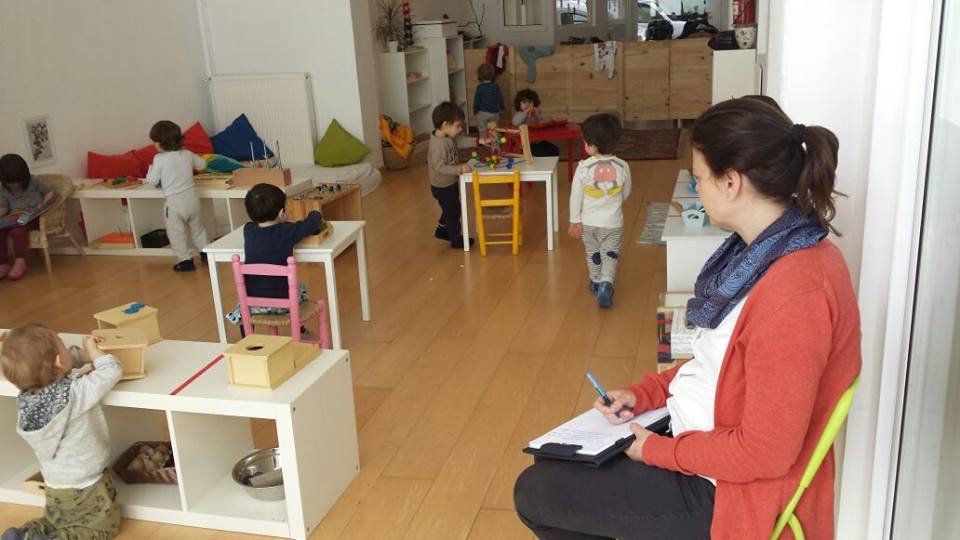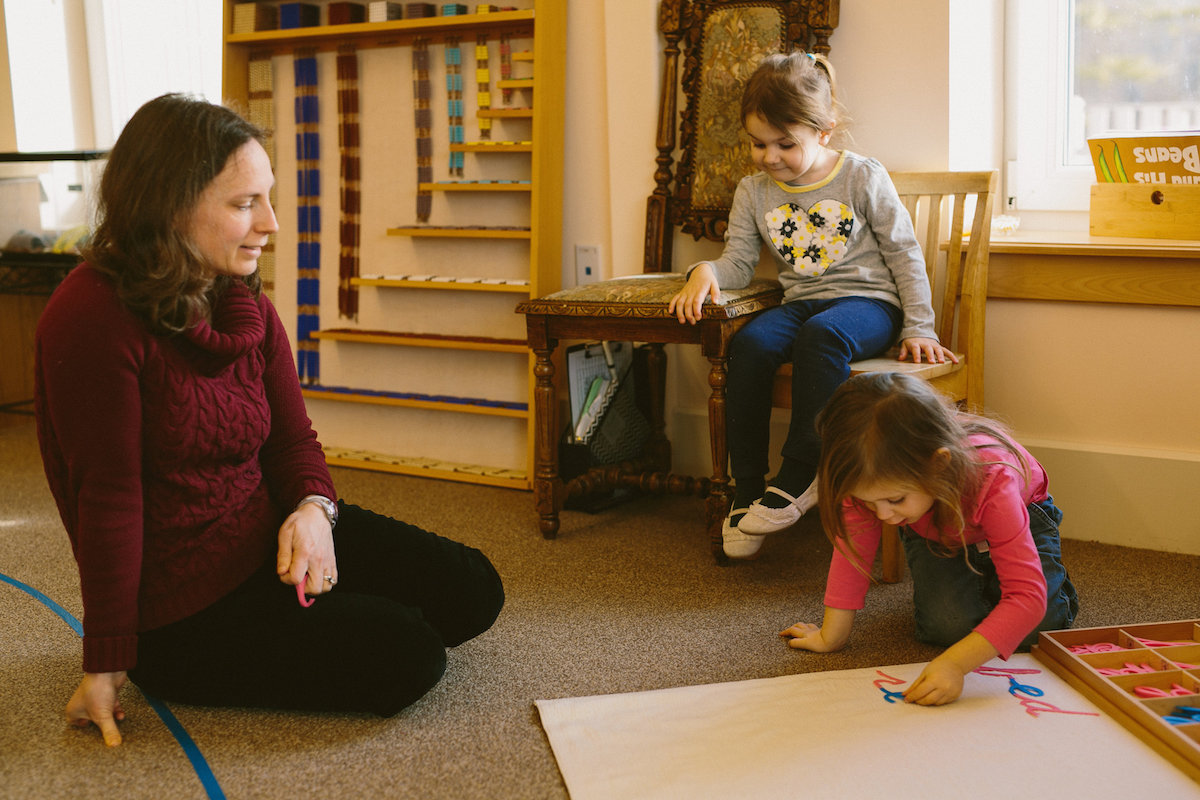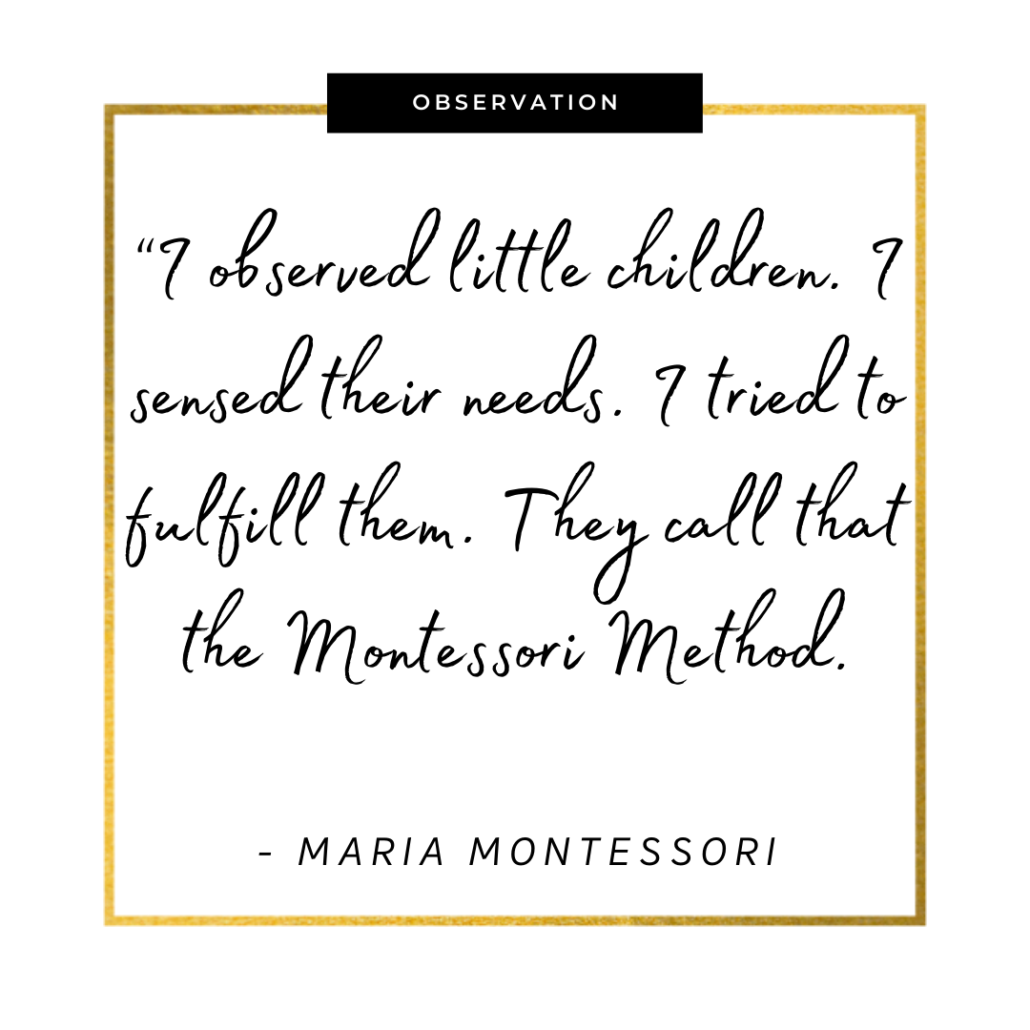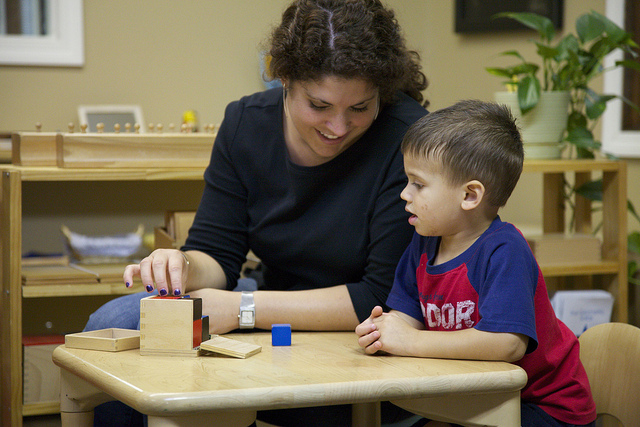What is Observation?
Generally people think of observation as sitting and looking at what is in front of them. Something a little boring.
Why boring?
Because I want to be involved with those children that are in front of me!
Dr. Montessori said, “The person who observes patiently, without feeling bored, has acquired an inner strength which must have been acquired through exercise” (Communications 19).

Source - https://www.montessoricg.com/wp-content/uploads/2020/04/133ec5_3c3c15587156486aa5ec449bf371302a_mv2.jpg
Why do we need to observe?
- We want to assist the children – Only thorough observation can we know where the help is needed? Is there any point showing a child how to do flower arrangement when he is yet to master scissoring skills?
- To see different individual’s life and their pace or rhythm in development – You may have shown 2 children color tablets at the same time – now one maybe ready for color box 3 and the other one may want to continue work with color box 2 – how will you know this without observation?
- To know how to offer help – a child maybe struggling with phonograms – how will you help this child without observing his natural inclination and style of learning?
- To understand which form of help is needed by the child – different children learn differently, how will you know this different without observing?

Source - https://images.squarespace-cdn.com/content/v1/51f1ba5de4b03517a1a03d38/1548776326530-B60BN74MQ9RB36G8RRA9/observation.jpeg
Goals of our Observation
So why this whole drama of observation?
Dr. Montessori says that “the purpose of the observation is to see what the children are doing independent of our presence and to examine what is seen in an objective manner in order to provide for the child’s inner development” (Communications 16).
- To comprehend and understand the needs of the child and respond to them – Once we observe, we are can now with fresh eyes, understand the behaviour and the needs of the child – for instance, why is this child not working with sensorial materials, but continuously tracing the SPL?
- To try to remove the obstacles the child faces in his development – For instance a child who is finding it difficult to write – how will you help her? What work can you offer to prepare her hand for writing?
- To collect the data objectively and respond appropriately – A child is not able to choose work by herself? How can you help – Limit the choices to 2 activities!

Source - https://inspiredmontessorilearning.com/wp-content/uploads/2021/05/Maria-Observation-Quote-1030x1030.png
How to observe
Dr. Montessori said, “That the observer should maintain perfect immobility of the soul, so as not to take part in any manifestation of feelings in the actions of the children. There must be no manifestations of enthusiasm, pleasure or joy, on the part of the observer” (Communications 19).
Why do prefer to observe without interaction?
To observe better, we need to live in the present. Not the past or the future but in the NOW. When observing, avoid all those random ideas that are coming into your head and just be present with those lovely little children that are in your environment that are so full of life and joy. That is what you want to be part of and we don’t necessarily have to always be interacting with it to be a part of it. Observation offers us that opportunity.
Thus we observe as scientists i.e. we observe with fresh eyes and knowledge. While observing, try to identify the needs, tendencies, sensitive periods and behavioral characteristics of the child.
Guiding Principles that Dr. Montessori Discovered through Observation
The first one is to observe without interfering. Like the rosary beads that Dr. Montessori gave to her teachers , give yourself something to do so that you don’t interfere – this could be as simple as drawing a triangle every time you feel the need to step in.
Ask yourself,
Is this a situation that needs intervention? Or, can silence be maintained to see how it works out? Being able to just sit and objectively observe is very important.
Part of this observation without interfering is that the work of the children has to be done by them. It can’t be done by someone else. We can’t do their work for them. Only the individual can learn for himself. If we don’t interfere, only then can the children make mistakes and thereby learn from them.
A second guiding principle is to observe in order to prepare the environment.
It means we set up the environment, offer materials and work based on our observation of the child , in the practical life area very often we introduce new materials suited to the developmental needs of the child staying true to the foundation she gave us - she observed in order to know how to prepare that environment.
A third principle is to observe and to link the child to the environment so that he can meet his needs. Sometimes, we have to observe to be able to create new materials that the child might need. Maybe we need to add canvas shoe washing, for example, to our environment for a country where people mostly wear canvas shoes.
Why does the Observation need to be scientific?
Scientific observation is objective observation. It doesn’t include judgments, feelings, or opinions, and it is not influenced by emotions or personal prejudices.
I’m going to give you an example of an observation I did in a scientific way without prejudices, without emotions, without my biases. Then I am going to give you the interpretation of the observation.
My husband was making breakfast one morning. He had a smoothie with a frozen kiwi, yogurt, peanut butter, and milk. He put all of the ingredients into a bowl and used a stick blender to blend them together. The blender made a lot of sounds and kept stopping and starting. He then walked away after saying he had too much yogurt and it needed some time to sit. Five minutes later he came back and continued to blend. That was the scientific observation.
Here is the interpretation of the same breakfast preparation. K had a smoothie with a frozen kiwi. There was no way he was going to be able to blend so many ingredients with a stick blender. He used a high sugar yogurt that probably made it taste sickly-sweet. He used peanut butter as he’s supremely health conscious. He then added milk and blended right away before the kiwi had thawed enough so the milk sloshed around and the kiwi got stuck in the blades. I think he broke the blender. He walked away to cover up his mistake saying he put too much yogurt in it and it needed time to sit. When he returned and continued blending the blender made a lot of loud sounds as he blended away and then it stopped. It definitely is broken.
Now if started interpreting immediately – Oh my God he’s broken the blender! It would distract me from observing the next step and also of him making a mistake and realising to not put so many ingredients together while blending. My takeback – guide him on how much a stick blender can take!
Kinds of Observation
Direct Observation
An important aspect to direct observation is that we dispel common misconceptions about children when we observe directly. These misconceptions maybe cultural or experiential
- that children are too young to do something,
- that children are too young to do for themselves,
- too young to focus for a long period of time,
- too young to remember from yesterday,
- to repeat over and over,
- too young not to have an adult to do for them,
- and too young to follow through and complete a task.
These are all misconceptions, which means they are not true. Practicing direct observation gives us a clear picture of what the child is capable of and motivates us to step out of the picture. It is important to take the time to directly observe in your classroom, at home, and in life

Source - https://baandek.org/wp-content/uploads/2012/11/montessoriguide.jpeg
Indirect Observation
As mentioned in the pre read, there are two aspects to indirect observation.
- One, we are trying to do two things at once: observe and work.
- Two, we have to recall later what we observed.
With the first aspect, observing and working, it is important to be present. Some people call indirect observation multitasking: being able to do many things at one time. But in fact, multitasking is not possible. Research has shown that our human brains cannot multitask; we cannot do two things at one time. We can do one thing and switch to another thing really fast. It seems like we can do two things at once, but physically our brains cannot do it. So, when you are in the moment and trying to work and observe, stop and focus on what is happening.
You can keep these three guidelines in mind that can help you to be more in the moment with your indirect observations
- The first one is focusing. Indirect observation needs to involve focusing. We just talked about how you can’t do more than one thing at a time. For example, you can’t read, talk on the phone, and watch TV. Although we try sometimes, we essentially can’t do it. So we need to focus
- The second is listening - We need to listen to others as well as listen to ourselves. Think about a time when a child wanted you to listen and all you could do was direct or lecture. For example, if your child came up to you and said, “Look at my painting!” What’s your first reaction? “Did you put your paint brush away? Did you put your apron away? Did you clean up the floor around it? I see some drips on this paper.” Instead, listening is validating what the child has to say, being alert and paying attention - “Your painting is so bright with colour! Tell me about it!”
- The last guideline for helping to observe indirectly is modelling. When you are practicing indirect observation, it is important to model. We need to model how to focus, we need to model how to listen, we need to model communication, movement, grace and courtesy, choices, responsibility, and the list goes on. Conscious modelling helps us to be present. It helps us to observe ourselves and the effect we are having on the environment. If I think about the way I am moving for example I become more present. I am not rushing and thinking about what is next. I am thinking and I am becoming what I feel the children need.
Keep a notebook and pencil in your pocket to help you write something down in the moment. Not pages of notes, but a few words to use as a reminder later that you can then expand upon when you are not with the children
Write down questions at the beginning of the day as a kind of commitment to yourself to focus on observing. What does Nyra do when she arrives? How are Vihaan’s hand skills?
Self-observation
This is not the type of observation that is typically shared on a daily basis. It is a life-long work that we do regardless of whether we are in the classroom or not. That is how we grow as human beings by analysing ourselves and working on ourselves. Self-observation helps us as adults become more and more aware of ourselves and how we are contributing to the environment
One important aspect of self-observation is coming to understand and satisfy our needs. Adults must be able to meet their own needs as a model to the children. If you can’t meet your own needs, you also most likely cannot meet someone else’s need.
Why do we need to know our personal needs in terms of our work with children? Children are in the process of learning how to meet their own needs. They look to us to help them meet their needs. If we model that we can meet our own needs, they come to understand that this is a human characteristic and that they too can meet their needs. And, if we meet our needs we feel good about helping the child to meet his needs.
What does the cabin crew tell you to do in case the air pressure drops?
Wear your mask first before helping others! If you’re breathless yourself, how are you going to help others?
Adult’s role
- To train our self to become competent observers.
- To develop the ability of blending the technical skill and appreciating the nature of our work.
- To acknowledge the powers of the child at that stage
- To understand to follow the child
- to prepare physically and psychologically to observe.
Some things to consider
Some questions that will help guide your observation include:
- In what ways are the children displaying independence?
- How do the children choose their work?
- What do transitions between work look like?
- How do the adults respond to the children?
- How do the children respond to the adults?
- How do the children interact with one another?
- How do the children care for their own basic needs?
- Are the children wandering?
- Are they interfering with other children’s work?
- Does anything about the classroom environment surprise you?
Few points to adhere to for objective and effective observation:
- Keep your mind open.
- Keep your mind still.
- Don’t judge.
- Be a scientific observer.
- Be objective.
- Watch and listen.
- Observe with interest, respect, responsibility and knowledge.
- Practice, practice, practice.


